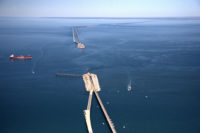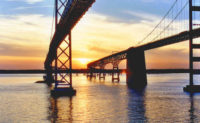After a five-year evaluation of more than a dozen potential locations for a new Chesapeake Bay crossing, the Maryland Transportation Authority will now focus on augmenting the bridge already in place.
The draft Tier 1 environmental study, released by the agency Feb. 23, proposes complementing the existing 4.3-mile dual-span suspension bridge with either a third bridge or a bridge-tunnel. The current tolled structure, incorporating separate spans constructed in 1952 and 1973, serves as the primary highway link to Maryland’s Eastern Shore from the state capital in Annapolis, and from Baltimore and metropolitan Washington, D.C.
Average weekday traffic volume of more than 68,500 vehicles nearly doubles in the summer, with millions of visitors using the bridge to access beach resorts in Maryland and Delaware.
Led by RK&K and AECOM, the study team narrowed the original set of 14 potential locations to three that underwent more detailed analysis. The preferred alternative, which would be built within a two-mile corridor encompassing the existing bridge, was deemed to provide the greatest degree of congestion relief with the least potential disruption to the bay’s sensitive wetlands and aquatic life.
Constructing a new span in close proximity to the original crossing would also allow the state to use existing landside infrastructure, including electronic toll collection equipment, and enable less disruptive traffic diversions during maintenance work and other closures.
The draft study estimates the cost of a bridge-only option at nearly $9 billion, with a tunnel addition increasing the cost to more than $13 billion.
Although the state will finalize its decision following public hearings this spring, it has not identified a source of funding for either the Tier 2 study or the new crossing itself.
In addition to supporting growing traffic volumes, a new span will also have to accommodate the bay’s primary shipping channels, which handle large volumes of ocean-going traffic as well as historic tall ships. Each of the existing structures provides a 3,200-ft long suspension span over the bay’s western channel with a vertical clearance of 186 ft.
At the outset of the Tier 1 study, Maryland transportation officials said the existing bridge can be maintained safely through 2065.
A project begun in September 2019 to rehabilitate the westbound structure’s deteriorated deck caused extensive traffic tie-ups until the combination of alternative milling methods, 24/7 operations and pandemic-reduced traffic volumes enabled allowed work finish in advance of the 2020 summer travel season.





Post a comment to this article
Report Abusive Comment